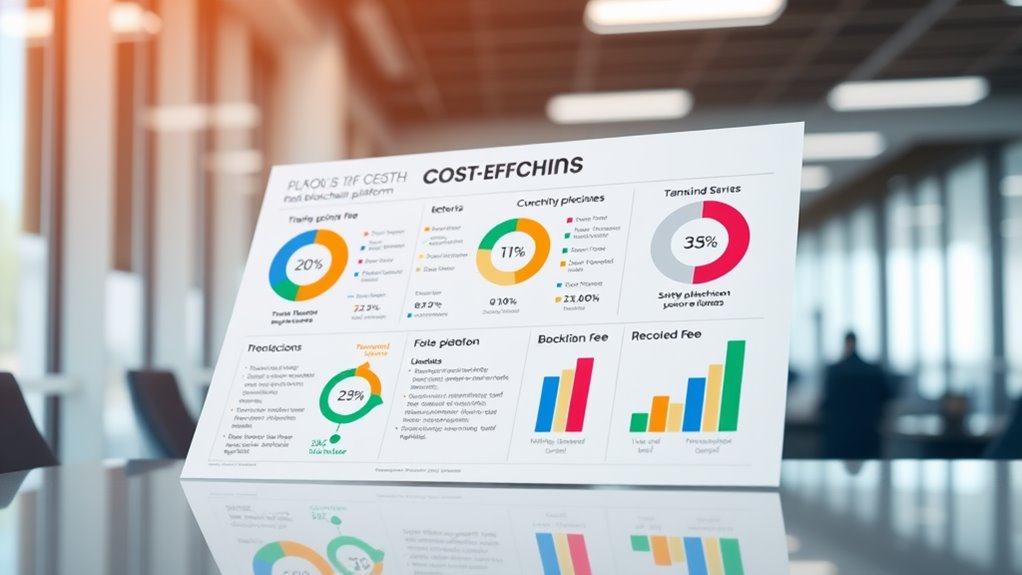
Top Blockchain Platforms: A Comprehensive Guide to Their Benefits
Modern blockchain platforms like Ethereum, Cardano, and Polkadot offer distinct features that revolutionize digital transactions and business operations. These platforms prioritize decentralization, security, and smart contract capabilities while implementing various consensus mechanisms for network integrity. Each platform provides unique benefits, from Ethereum's extensive DeFi applications to Cardano's enhanced security through Haskell-based Plutus. Understanding the specific advantages of leading blockchain networks reveals their transformative potential across multiple industries.
Key Takeaways
- Ethereum leads the DeFi ecosystem with extensive smart contract capabilities through Solidity and supports thousands of decentralized applications.
- Hyperledger provides enterprise-focused solutions with multiple programming language support and customizable privacy controls for business needs.
- Cardano offers enhanced security through its Haskell-based Plutus framework and scientific research-driven development approach.
- Binance Smart Chain delivers cost-effective transactions while maintaining Ethereum compatibility, making it accessible for developers and users.
- Polkadot enables cross-chain communication and scalability through its unique parachain architecture and Substrate development framework.
Essential Features That Define Modern Blockchain Platforms

While blockchain technology continues to evolve, several essential features have emerged as defining characteristics of modern blockchain platforms. At their core, these platforms prioritize decentralization, operating through distributed networks of nodes rather than relying on central authorities. This structure guarantees both system resilience and resistance to censorship.
These platforms are distinguished by their immutable and transparent nature, where all transactions become permanent records visible to network participants. Smart contract capabilities enable automated execution of agreements, while various consensus mechanisms, such as Proof of Work and Proof of Stake, maintain network integrity.
The underlying distributed ledger technology guarantees secure record-keeping across all nodes, with encrypted data maintaining security. Modern platforms also emphasize modularity and customization, allowing organizations to adapt the technology to their specific needs while maintaining enterprise-grade security standards. Cryptographic security ensures that each transaction is verified and protected through complex mathematical algorithms before being added to the blockchain.
Security and Privacy Mechanisms in Leading Blockchain Networks

As blockchain networks continue to evolve, robust security and privacy mechanisms have become fundamental components of their architecture. Modern platforms implement multiple layers of protection through cryptographic techniques, consensus algorithms, and privacy measures to safeguard transactions and user data.
Leading blockchain networks incorporate essential security features:
Modern blockchain platforms deploy critical security measures as foundational elements to protect network operations and user assets.
- Asymmetric encryption and digital signatures verify transaction authenticity while maintaining user pseudonymity.
- Consensus mechanisms like Proof-of-Work and Proof-of-Stake prevent fraudulent activities through mathematical validation.
- Zero-knowledge proofs enable transaction verification without exposing sensitive information.
These security measures work in conjunction with blockchain's inherent characteristics of immutability and decentralization.
The distributed nature of blockchain networks eliminates single points of failure, while cryptographic hashing ensures data integrity. Additionally, private and permissioned blockchains offer enhanced privacy controls for enterprises requiring stricter data protection.
Proper key management practices remain crucial for users to protect against unauthorized access and potential theft of digital assets.
Smart Contract Capabilities Across Major Platforms

Building upon the secure foundation of blockchain networks, smart contract capabilities represent a defining feature that distinguishes modern blockchain platforms from one another.
Each platform offers unique advantages in smart contract functionality, with Ethereum leading through its robust Solidity language and extensive DeFi applications.
Cardano utilizes Haskell-based Plutus for enhanced security, while Polkadot enables cross-chain communication through Ink and Substrate frameworks.
Binance Smart Chain provides cost-effective solutions with Solidity compatibility, and Hyperledger caters to enterprise needs with multiple language support.
These platforms serve diverse applications, from NFT marketplaces to supply chain management and healthcare systems.
Their varying consensus mechanisms, from Ethereum's Proof of Stake to Cardano's Ouroboros, further influence smart contract performance and efficiency across different use cases.
The recent Ethereum Merge transition demonstrates how blockchain platforms can evolve their consensus mechanisms to improve efficiency while maintaining robust smart contract functionality.
Transaction Speed and Scalability Solutions

Layer 2 scaling solutions represent a significant advancement in blockchain technology, offering enhanced transaction processing capabilities while maintaining the security of the main chain.
These solutions, including prominent examples like the Lightning Network and Polygon, operate as separate protocols built on top of existing blockchains to handle transactions more efficiently.
Cross-chain optimization further expands these capabilities by enabling different blockchain networks to communicate and transfer assets seamlessly, creating a more interconnected and efficient ecosystem for users and developers.
Both Optimistic and ZK rollups provide innovative approaches to increase throughput while inheriting the robust security guarantees of the underlying blockchain network.
Layer 2 Scaling Solutions
With the growing demand for faster blockchain transactions, Layer 2 scaling solutions have emerged as vital infrastructure components that operate above traditional blockchain networks.
These solutions process transactions off-chain while maintaining security through final settlement on the main blockchain, effectively reducing congestion and costs.
Layer 2 technologies offer several benefits that address common blockchain limitations:
- Considerably increased transaction speeds and reduced fees through efficient bundling and processing
- Enhanced scalability without compromising the security of the main chain
- Flexible implementation options, including state channels, sidechains, and rollups
Popular implementations include Ethereum's Optimistic Rollups and Bitcoin's Lightning Network, which demonstrate the practical application of Layer 2 solutions in major blockchain platforms.
While these solutions introduce some complexity, they represent a vital advancement in blockchain technology's evolution toward mainstream adoption.
Cross-Chain Transaction Optimization
As blockchain networks continue to evolve, cross-chain transaction optimization has emerged as a critical solution for enhancing interoperability and scalability across different blockchain platforms.
Through distributed ledger technology and multi-chain architecture, these solutions enable seamless communication between different networks while considerably improving transaction speeds and reducing congestion.
Key platforms like Polkadot, Cosmos, and Harmony facilitate this optimization by leveraging automated processes and smart contracts to distribute transaction loads effectively.
These implementations not only increase overall throughput but also optimize resource usage, resulting in lower transaction costs.
The integration of secure blockchain bridges and super contract pairs ensures safe asset transfers between chains, while sophisticated creditworthiness models maintain transaction reliability.
This thorough approach to optimization supports the expanding blockchain ecosystem, accommodating growing user demands and complex applications.
The implementation of wrapped tokens across multiple blockchain networks helps maintain asset value and functionality while enabling seamless cross-chain transfers.
Cross-Chain Communication and Interoperability Standards

The rapid evolution of blockchain technology has highlighted the critical need for effective cross-chain communication and standardized interoperability protocols. Cross-chain solutions enable seamless interactions between different blockchain networks through various mechanisms, including atomic swaps, blockchain routers, and smart contract bridges.
Key developments in cross-chain communication include:
- Integration of Hashed TimeLock Contracts (HTLCs) to guarantee secure, trustless transactions between different blockchains
- Implementation of multi-chain frameworks that create standardized ecosystems for enhanced communication
- Development of specialized protocols like Cosmos' Inter-Blockchain Communication (IBC) for secure data exchange
These advancements face challenges such as diverse consensus models and smart contract incompatibilities.
However, ongoing innovations in decentralized oracle networks and cross-chain bridges continue to improve interoperability, making blockchain technology more accessible and efficient for widespread adoption.
The integration of decentralized finance applications with enhanced cross-chain capabilities is expected to drive significant growth in blockchain interoperability by 2025.
Governance Models and Community Participation

Blockchain governance models represent fundamental frameworks that determine how networks evolve, implement changes, and resolve conflicts through structured decision-making processes.
These models typically fall into three main categories: on-chain, off-chain, and hybrid governance systems, each offering distinct approaches to community participation and consensus building.
On-chain governance enables direct voting through blockchain mechanisms, providing transparency and immutability, while off-chain governance facilitates discussions through external platforms. Community members can participate through various mechanisms, including voting systems, proposal submissions, and delegation of voting power.
Blockchain governance empowers communities through transparent voting mechanisms while fostering open dialogue and collaborative decision-making across diverse platforms.
However, networks often face challenges such as voter apathy and the need to balance diverse stakeholder interests. Prominent platforms like Tezos and MakerDAO demonstrate successful implementation of these governance structures, utilizing decentralized decision-making processes to maintain network stability and growth.
The implementation of reliable audit trails through blockchain governance helps enterprises establish more secure and transparent business operations while reducing operational costs.
Enterprise Applications and Business Integration

The implementation of enterprise blockchain solutions requires careful consideration of integration costs against potential returns, with companies needing to evaluate both immediate expenses and long-term benefits.
Security measures and data privacy protocols must align with existing business frameworks while meeting industry-specific compliance requirements, particularly in sectors handling sensitive information.
Organizations often face the challenge of deploying solutions across multiple platforms and legacy systems, necessitating standardized protocols and robust middleware solutions to guarantee seamless operation.
The rise of decentralized finance platforms has created new opportunities for businesses to streamline transactions while reducing dependency on traditional financial intermediaries.
Integration Costs and ROI
Successfully integrating blockchain technology into existing enterprise systems requires careful consideration of both initial investment costs and potential returns on investment (ROI). Organizations must evaluate infrastructure requirements, development costs, and ongoing maintenance expenses while appraising the technology's long-term value proposition.
- Extensive integration costs include system upgrades, custom API development, and specialized technical expertise, which can greatly impact initial budgets.
- ROI manifests through enhanced operational efficiency, reduced transaction costs, and improved data transparency across business processes.
- Implementation challenges involve regulatory compliance, cybersecurity measures, and change management, requiring careful planning and resource allocation.
The integration process demands thorough analysis of existing systems, scalability needs, and potential adoption barriers.
Organizations should consider both immediate expenses and long-term benefits when developing their blockchain implementation strategy.
Security and Data Privacy
Securing enterprise blockchain implementations demands a thorough approach to data privacy and protection, incorporating multiple layers of security measures and compliance protocols.
Platforms like Hyperledger Fabric, Quorum, and XDC Network offer robust security features, including permissioned access control and advanced encryption techniques. These systems utilize zero-knowledge proofs and custom data-centric security solutions to maintain GDPR compliance while protecting sensitive information.
The decentralized architecture of blockchain platforms provides inherent security benefits through immutable transactions and transparent record-keeping.
However, organizations must address key challenges, including private key management, scalability issues, and potential 51% attacks. Implementation of multi-factor authentication, regular security audits, and strict access management protocols helps guarantee data integrity while meeting regulatory requirements across different jurisdictions.
Organizations should carefully evaluate whether public or private blockchains better align with their security requirements and compliance needs.
Cross-Platform Solution Deployment
Modern enterprise blockchain deployment requires thorough cross-platform solutions that seamlessly integrate with existing business infrastructure while maintaining operational efficiency. Organizations must carefully analyze platforms based on their specific needs, considering factors like scalability, interoperability, and customization capabilities.
The selection process involves evaluating platform activity, architecture support, and operational costs.
Key considerations for successful deployment include:
- Integration with existing systems through custom APIs and infrastructure upgrades
- Compliance with regulatory requirements and security standards
- Staff training and operational readiness for blockchain adoption
Popular platforms like Ethereum, Hyperledger Fabric, and Oracle Blockchain Platform offer diverse solutions for enterprise needs.
These platforms provide varying levels of smart contract functionality, pre-assembled services, and integration capabilities, allowing businesses to choose options that align with their specific requirements and growth objectives.
The decentralized ledger system ensures transparent and secure transactions without relying on centralized authorities, making it ideal for enterprise-wide implementations.
Cost-Effectiveness and Transaction Fee Structures

As blockchain technology continues to evolve, transaction fee structures and cost-effectiveness have become essential factors in platform selection. Modern platforms offer varying fee structures, with newer solutions providing considerably lower costs compared to traditional networks. Platforms like Ripple and Solana lead in cost-effectiveness, charging mere fractions of a cent per transaction.
| Platform | Transaction Fee | Transaction Speed | Key Feature |
|---|---|---|---|
| Ripple | $0.0002 | 1,500 TPS | Cross-border focus |
| Solana | $0.00025 | 65,000+ TPS | Ultra-fast processing |
| Tron | $0.0001 | 2,000 TPS | DeFi optimized |
| Ethereum | $0.50-$5.00 | 15-45 TPS | Smart contracts |
The implementation of various consensus mechanisms, particularly Proof of Stake and Delegated Proof of Stake, has enabled platforms to maintain security while reducing operational costs and energy consumption.
Real-World Implementation Success Stories

Numerous blockchain implementations across diverse industries have demonstrated remarkable success in solving real-world challenges. Companies like IBM, Walmart, and Maersk have leveraged blockchain technology to transform their operations and achieve measurable results in supply chain management, financial services, and logistics.
- IBM Food Trust has revolutionized food industry transparency, enabling real-time tracking of products from farm to table, enhancing food safety and consumer trust.
- Maersk's TradeLens processes over 20 million shipping events daily, considerably reducing documentation errors and shipment delays in global trade.
- JPMorgan Chase's Onyx platform handles more than $1 billion in daily transactions, streamlining cross-border payments and reducing settlement times through blockchain technology and JPM Coin implementation.
These implementations demonstrate blockchain's practical value in addressing complex business challenges while improving operational efficiency.
Frequently Asked Questions
How Long Does It Take to Become Proficient in Blockchain Development?
Becoming proficient in blockchain development typically takes 1-2 years, including learning programming fundamentals, specialized blockchain technologies, and gaining practical experience through projects. Continuous learning remains essential for maintaining expertise.
What Programming Languages Should Beginners Learn First for Blockchain Development?
Beginners should start with Solidity for smart contracts and JavaScript for blockchain applications. Python is also recommended for its simplicity. These languages provide essential foundations for blockchain development and have strong community support.
Can Private Blockchains Be Converted to Public Networks Later?
Like transforming a secured garden into a public park, private blockchains can be converted to public networks. However, this process requires significant architectural changes, security modifications, and careful consideration of scalability and governance mechanisms.
How Much Initial Investment Is Typically Needed to Launch a Blockchain Project?
Initial blockchain project investments typically range from $100,000 to $500,000, covering development, compliance, and marketing costs. Simple projects may start at $50,000, while complex enterprise solutions can exceed $500,000.
Are Blockchain Platforms Vulnerable to Quantum Computing Attacks?
Like a telegraph vulnerable to interception, blockchain platforms face significant risks from quantum computing attacks. Current cryptographic methods could be compromised, particularly RSA and ECDSA algorithms, necessitating quantum-resistant solutions for future security.
Conclusion
Blockchain platforms have proven they're worth their weight in gold, offering revolutionary solutions across industries. From robust security mechanisms and smart contracts to scalable transaction processing and cross-chain compatibility, these systems continue to evolve. As enterprises increasingly adopt blockchain technology, its impact on business operations, governance, and digital innovation becomes more apparent. The future of blockchain platforms appears promising, with continued advancement in functionality and real-world applications.












